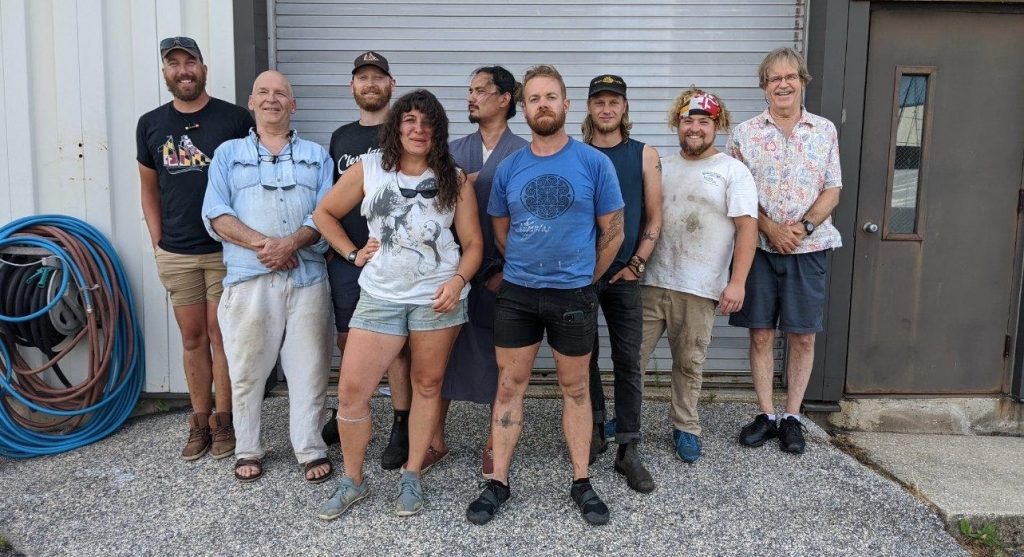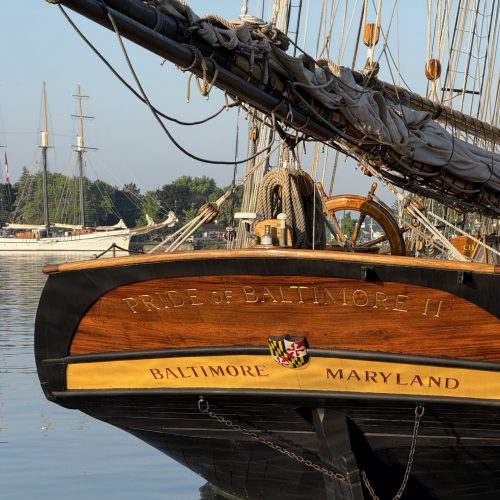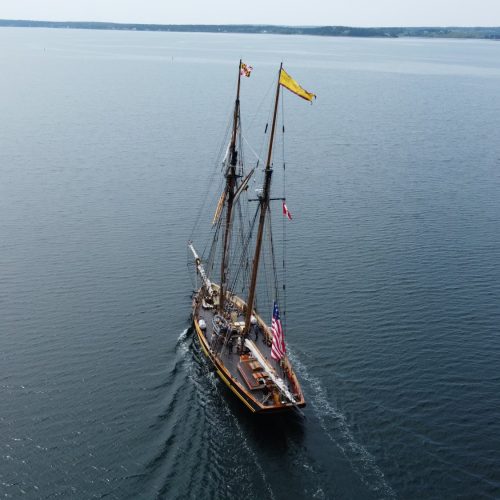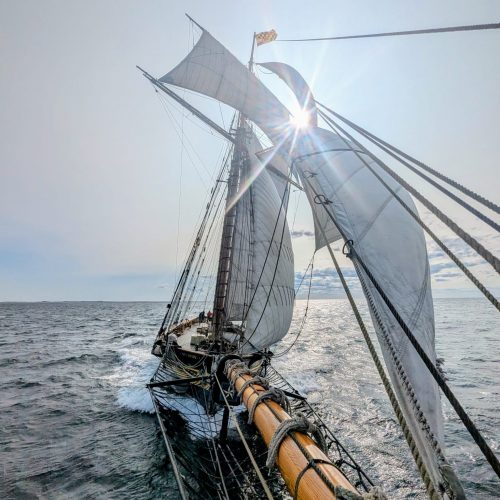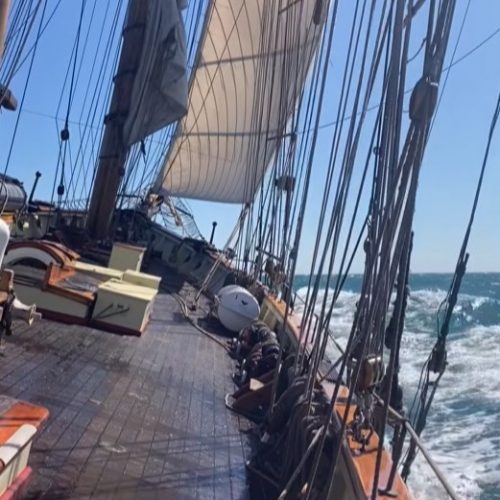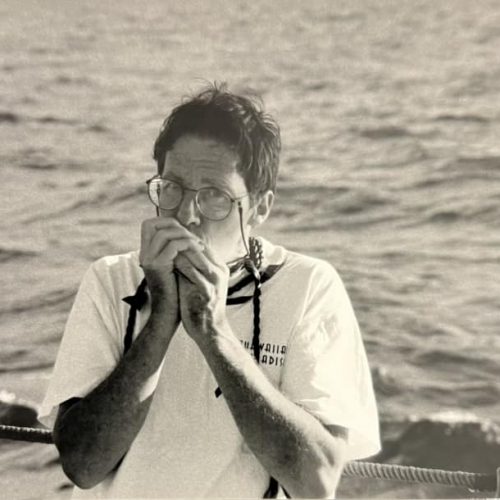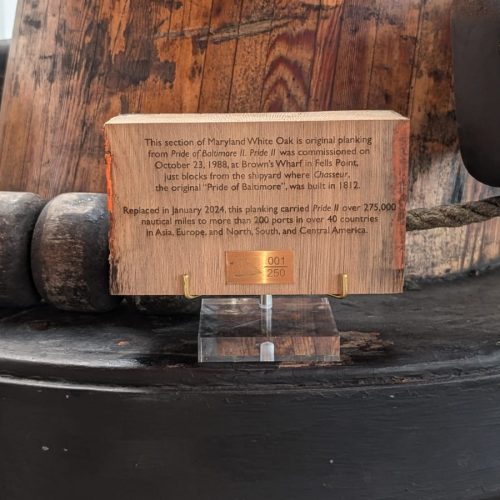Photo: A tradition in recent years, the crew gathered for a quick end-of-season photo. From left to right: Chief Mate Jeff Crosby, Phil Keenan, Joe Byington, Shevawn Innes, David Stolz, Chad Lossing, James Rogers, Blake Lowry, Captain Jan Miles.
Tuesday, June 16, 2020
Today is the last day of layup work by Pride’s 2020 liveaboard seasonal sailing crew. At the end of this day, when layup preparation is complete, the liveaboard crew will be heading toward futures not clear, except that they know where they will be sleeping ashore.
The process of protecting the ship for this long-term layup is without much mystery. Every winter layup includes covering the ship to protect her from direct sunlight and precipitation. The ship was already in winter layup when the decision for continuing into a long-term layup was forced for the rest of that year of 2018. A never-before layup spanning more than a full calendar year. A lot was learned after that layup about what happens to the ship for any layup that includes summer months.
Passive ventilating, under the well-ventilated design of the sun and rain blocking ship’s cover that we use every winter between active sailing seasons, is not adequate during summer layup months for preventing mold buildup down below nor plank seams opening up more than they do during short winter layups. During the summer, unlike during winter months, the average wind speed is much reduced and the humidity is much increased. While the ship’s cover protects from direct sunlight and precipitation, the low-velocity summer winds are not enough to stir air down below, as do winter winds flowing through the cover over deck openings. The lesson we learned is that it requires artificial wind under the cover and inside the ship to reduce the chance of growing mold down below. So, this time around for this summer layup, there are numerous fans moving air on deck, down below, and even in the bilges.
To reduce plank seam opening through this extended summer layup ahead of the normal winter layup, there will be regular wetting of deck and topside plank seams. Two to three times a week, we think. This will be a significantly time-consuming activity. Likely each wet down will take a couple of hours.
Knowing well in advance the decision to lay up the ship for this pandemic year, extra time was taken to cover Pride’s big lower masts with extra coats of protecting oil, plus a “holding coat” of glossy/reflective varnish. The crew also soaked additional tar on the exposed parts of the wire standing rigging that is covered with tarred marlin. The ten-foot-tall (long) tops of the lower masts, the doublings, as we call them because of the overlap between lower end of topmasts and upper end of lower masts (hence the term doubling), are painted black and apt to get pretty hot from the sun. This leads to the growth of small checks in the painted surface through the increased heat. The black painted areas at the top of the big lower masts have been given “shade” from the sun by a covering system that provides an air space between the shade cover and the black painted mast doublings. The shade is installed in a fashion estimated to be robust for the significant wind speeds that can occur at the height of the doublings.
We also hang a sun-blocking skirt between ship’s cover and the waterline on the starboard side every layup. This became important during the shorter length wintertime layups because of the orientation of the ship. She is moored pointed east. All winter long, her starboard side was receiving daily doses of direct sunlight and we observed seams opening in some parts of her topside planking over the relatively short winter. The skirting reduced the amount of opening to nearly no opening at all. Except for occasions of a full summer layup. A fair amount of compensating caulking and replacement seam compound above the waterline was required before sailing after the first full year of layup. This time round, we hope periodic wetting will be effective at reducing, if not preventing, seams from opening, such as we observed during the last summertime layup.
Last time (in 2018), the long-term layup was due to an unforeseen extreme budget shortfall that not only laid the ship up, but laid off all the senior marine staff and nearly all of the full-time company staff. This time, the layup cause is the global pandemic. With state legislature support for a span of five years that started late 2018 and an active staff since early 2019 raising funds and earning grants, as well as developing direct ship use income, there are funds for keeping the company running through the rest of this year. However, not enough to keep the ship sailing. Thus the staff will be able to continue to make plans for next year’s campaigning of the ship. Meanwhile, the company will also keep key senior marine staff employed for assisting with planning while also caring for and maintaining the ship. Hence this layup will include ship maintenance as well as increased attention to preservation while we all await sailing again next year.
Maintenance that will occur between the bit of sailing done this year and the plan for a full season next year will include a number of unessential desires. Like replacing the galley counter around the galley sink due to the accumulation of water contamination of the end grain of galley counter wood. There will also be some detailed cosmetic care in the galley. This layup will also provide some time that is hard to set aside during winter layups between fully active sailing seasons for making replacement blocks rather than purchasing new. “Shipkeeper” Chief Mate Jeff Crosby’s highly skilled carpentry will be put to use creating jigs for standardizing the making of block-shell pieces that can be assembled into shells of blocks. It will be a relatively simple matter of shifting sheaves and sheave-pins to the newly assembled shells. Leaving future sailing crew to re-strop new blocks when it is time to replace the old shells. (Easy for me to say … eh?)
Meanwhile, I hope all the departing crew and you readers of these logs remain diligent.
Signed,
Jan C. Miles
Senior Captain

